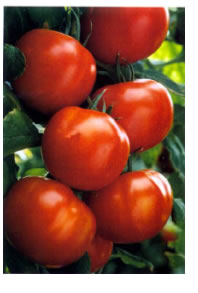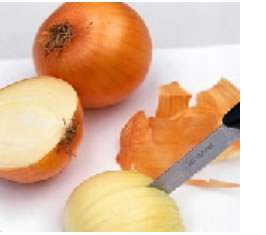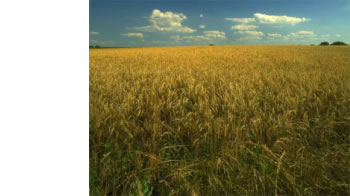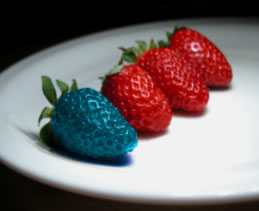SCIENCE
ENHANCEMENT PROGRAMME |
||||||||
 |
||||||||
| quick link: menu | intro | D | E | F | G | ||||||||||||||||||||||
|
||||||||||||||||||||||
|
Developed
by Holly Cook. Sc2, Selective breeding Canon Lee School, York
• select scientific evidence in a news article; Outcomes • decide whether each article is true or false;
Stress the importance of finding evidence (different sources, “trusted” Internet sites/newspapers, journals, and peer-reviewed work). The false article is “strawberry fields”. In this
example the new GM food has been tested on human subjects (children)
before being granted a license. This would not be possible. All
names, quotes and places are completely fabricated in this example
and, although the scientific idea is possible, it has not been
done (so far!). Misconceptions There has been little research about pupils’ misconceptions in the area of genetic modification, probably because it is a relatively new technology and not a specific learning objective of the national curriculum. However, some misconceptions were discovered in teaching this lesson and these were: • GM food can kill you/is bad for you;
• Begin by sharing the learning objectives with pupils. Use the tomato sauce as an example, asking key questions to explore pupils’ existing ideas about genetic modification. Explain the principles of GM. • Explain to the pupils that they will be given 4 news stories about GM foods, one of which is false. • Give out the stories to each group of pupils. Each pupil reads the story and then, as a group, they come up with three reasons why they think it is either true or false. • Ask pupils to think carefully about what they might base their reasons on because they will be asked to defend their decisions to the rest of the class. • In the plenary, collect decisions from each group. Get an idea of the overall consensus. Discuss problems pupils might have had in reaching decisions.
Genetic modification involves altering an organism's DNA. This can be done by altering an existing section of DNA, or by adding a new gene altogether. A new gene can be added from one individual to another from the same species, e.g. tomato gene into another tomato plant, or between individuals from two different species, e.g. tomato gene into a fish. It is possible to transfer genes from one species to another from plant to plant, from animal to plant, from plant to animal or from animal to animal. This is because all genes, no matter where they come from, are made of DNA. How to add a fish gene into a tomato The flounder has a gene to make chemical antifreeze. This is
removed from the chromosomes within a flounder cell. The recombinant DNA, including the antifreeze gene, is placed in a bacterium. The bacterium is allowed to reproduce many times producing lots of copies of the recombinant DNA. Tomato plant cells are infected with the bacteria. As a result, the antifreeze gene in the plasmids, in the bacteria, becomes integrated into the tomato plant cell DNA. Tomato cells are placed in a growth medium that encourages the cells to grow into plants. Tomato plant seedlings are planted. The GM tomato plants contain a copy of the flounder antifreeze gene in every one of their cells.The plants are tested to see if the fish gene still works and whether they are now frost resistant. [Click either the PDF or Word button at the bottom of the screen to open this page for printing or editing] Pupil activity sheet 1: Genetically Modified Foods
• Our group thinks that this story is true / false because
… _________________________________________________________________________ ________________________________________________________________________________________________________________________ • Why did the scientists want to make this new type of food? ______________________________________________________________________ ________________________________________________________________________________________________________________________ Pupil activity sheet 2: Genetically Modified Foods
• Our group thinks that this story is true / false because
… _________________________________________________________________________ ________________________________________________________________________________________________________________________ • Why did the scientists want to make this new type of food? ______________________________________________________________________ ________________________________________________________________________________________________________________________
Pupil activity sheet 3: Genetically Modified Foods
• Our group thinks that this story is true / false because
… _________________________________________________________________________ ________________________________________________________________________________________________________________________ • Why did the scientists want to make this new type of food? _______________________________________________________________________ ________________________________________________________________________________________________________________________
Pupil activity sheet 4: Genetically Modified Foods
• Our group thinks that this story is true / false because
… _________________________________________________________________________ ________________________________________________________________________________________________________________________ • Why did the scientists want to make this new type of food? _______________________________________________________________________ ________________________________________________________________________________________________________________________
|
||||||||||||||||||||||
|



